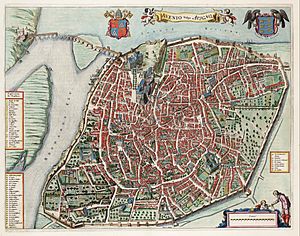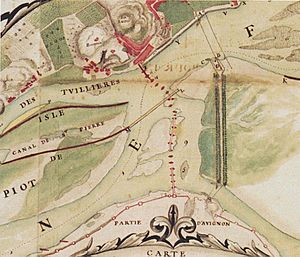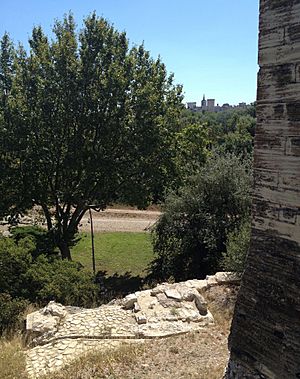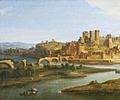Pont Saint-Bénézet facts for kids
Quick facts for kids Pont Saint-Bénézet |
|
|---|---|
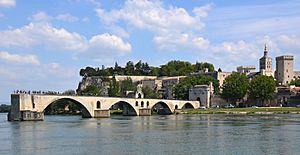
The surviving four arches of the Pont St-Bénézet
|
|
| Built | 1177–1185 |
| Official name: Historic Centre of Avignon: Papal Palace, Episcopal Ensemble and Avignon Bridge | |
| Type | Cultural |
| Criteria | i, ii, iv |
| Designated | 1995 |
| Reference no. | 228 |
| State Party | |
|
Monument historique
|
|
| Official name: Chapelle et pont Saint-Bénézet | |
| Designated | 1840 |
| Reference no. | PA00081815 |
| Lua error in Module:Location_map at line 420: attempt to index field 'wikibase' (a nil value). | |
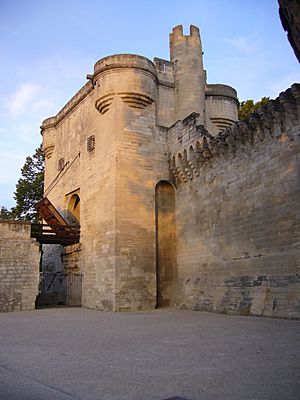
The Pont Saint-Bénézet (also called the Pont d'Avignon) is a very old bridge in the city of Avignon, in southern France. It is famous around the world because of a popular French song.
The first bridge was made of wood. It was built between 1177 and 1185. It crossed the Rhône river, connecting Avignon with Villeneuve-lès-Avignon. This first bridge was destroyed in 1226 during a war.
Building a new bridge started in 1234. This time, it was made of stone. It had 22 stone arches and was about 900 meters (980 yards) long. It was only about 4.9 meters (16 feet) wide. The bridge was left unused in the mid-1600s. This was because the Rhône river often flooded, causing the arches to break and fall. It was too expensive to keep fixing it.
Today, only four arches and a gatehouse on the Avignon side of the bridge are still standing. A small Chapel dedicated to Saint Nicholas is built on the second pier of the bridge. The bridge is a very important landmark in Avignon. In 1995, it became a World Heritage Site, along with the Palais des Papes (Pope's Palace) and the Avignon Cathedral.
Contents
History of the Bridge
The first bridge was built between 1177 and 1185. It was destroyed in 1226 when Louis VIII of France attacked Avignon. People started rebuilding it in 1234. Many historians think the first bridge was mostly wood. The second bridge was built entirely of stone.
This stone bridge had 22 arches and 21 piers (supports). It was about 900 meters (980 yards) long. It wasn't straight but had a curved path. This was probably because of the islands in the river at that time. The bridge was quite narrow, only about 4.9 meters (16 feet) wide, including the walls on the sides.
The arches often broke when the river flooded. Sometimes, temporary wooden parts were used to fix them. Later, they were rebuilt with stone.
Why the Bridge Collapsed
The bridge started to fall apart in the 1600s. By 1644, four arches were already missing. A big flood in 1669 destroyed even more of the bridge. After that, the other arches slowly collapsed or were taken down. By 2020, only four arches remained. Parts of other piers are now buried under dirt on the island or at the bottom of the river.
The arches of the bridge are not perfectly round like Roman arches. They are more like a segment of a circle. The largest gap between the remaining arches is about 35.8 meters (117.5 feet). The piers have pointed ends, called cutwaters, both upstream and downstream. These help to reduce the force of the water during floods. This makes the bridge more stable. The piers also had holes to help with water pressure during floods.
After the Saint-Bénézet bridge was abandoned, people crossed the Rhône river by ferry. This continued until the early 1800s. Later, new bridges were built nearby to help people cross the river.
The Legend of Saint Bénézet
The building of the bridge was inspired by a young shepherd boy named Bénézet. He came from a small village called Villard. The story says that while he was looking after his sheep, he heard the voice of Jesus Christ. Jesus told him to build a bridge across the river.
At first, people made fun of him. But Bénézet "proved" his special message by magically lifting a very large stone block. This convinced people to support his project. He then formed a group called the Bridge Brotherhood to help build the bridge.
After he died, Saint Bénézet was buried right on the bridge. His body was placed in a small chapel on one of the bridge's piers, on the Avignon side.
Saint Nicholas Chapel
The Saint Nicholas Chapel is located on the second pier of the bridge. It has been rebuilt and repaired many times over the years. It has two floors, each with a main room (nave) and a rounded end (apse). The upper floor is at the same level as the bridge walkway. It makes the walkway narrower, only about 1.75 meters (5.7 feet) wide at that spot. There are steps to go down to the lower floor from the bridge.
The outside of the chapel shows signs of all the rebuilding. For example, some windows on the south-eastern wall are now blocked. The roof is made of stone tiles. The lower chapel's apse has five decorated arches from the 12th century. The upper chapel was made sacred in 1411. In 1513, a new, pointed apse was added to the upper chapel.
In 1670, after the bridge was abandoned, Saint Bénézet's remains were moved to a hospital in Avignon. The bridge was also important to Rhône boatmen. Their patron saint was Saint Nicholas. They used to worship in the Saint Nicholas Chapel on the bridge. But because the bridge was in such bad shape, they built a new chapel on dry land in 1715. This new chapel was destroyed by a flood in 1856.
Bridge Gatehouses
The bridge was very important for travel and trade. When it was built, it was the only way to cross the Rhône river between Lyon and the Mediterranean Sea. It was also the only crossing between the Pope's land (Comtat Venaissin) and the land controlled by the kings of France.
Because it was so important, it was heavily guarded on both sides. On the French side, the strong fortress of the Tour Philippe-le-Bel was built nearby in the early 1300s. On the Avignon side, a large gatehouse was built in the 1300s and changed in the 1400s. The bridge walkway went over the city wall and down a ramp into the city.
In 1840, the Chapel of Saint Nicholas and the four remaining arches were officially recognized as a Monument historique (historic monument).
The Song "Sur le Pont d'Avignon"
The Pont Saint-Bénézet became famous worldwide because of the children's song "Sur le Pont d'Avignon" ("On the Bridge of Avignon").
An older version of this song was popular in the 1500s and 1600s. The music was first printed in 1503-1504. A composer named Pierre Certon even used the tune in a church mass.
The modern version of the song we know today comes from the mid-1800s. It was included in an opera called Le Sourd ou l'Auberge pleine, which was first performed in Paris in 1853.
Related pages
- List of medieval bridges in France
Pictorial record
-
View towards Villeneuve by Étienne Martellange, 1608. Arch 7 has collapsed. Five arches near Villeneuve (18-22) are still standing.
-
The ruined bridge as depicted by Joseph Vernet, 1756. Arches 9 and 11 are still standing.
Images for kids
See also
 In Spanish: Puente de Aviñón para niños
In Spanish: Puente de Aviñón para niños


